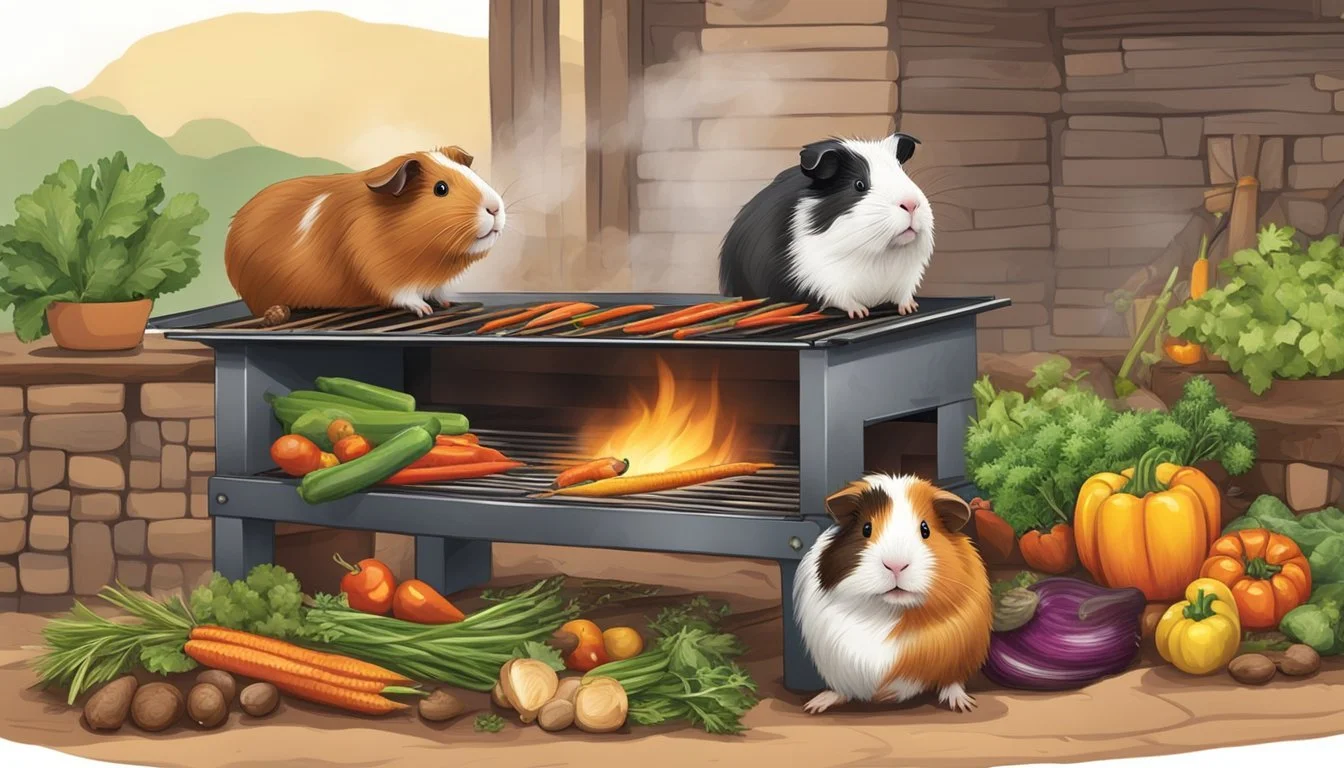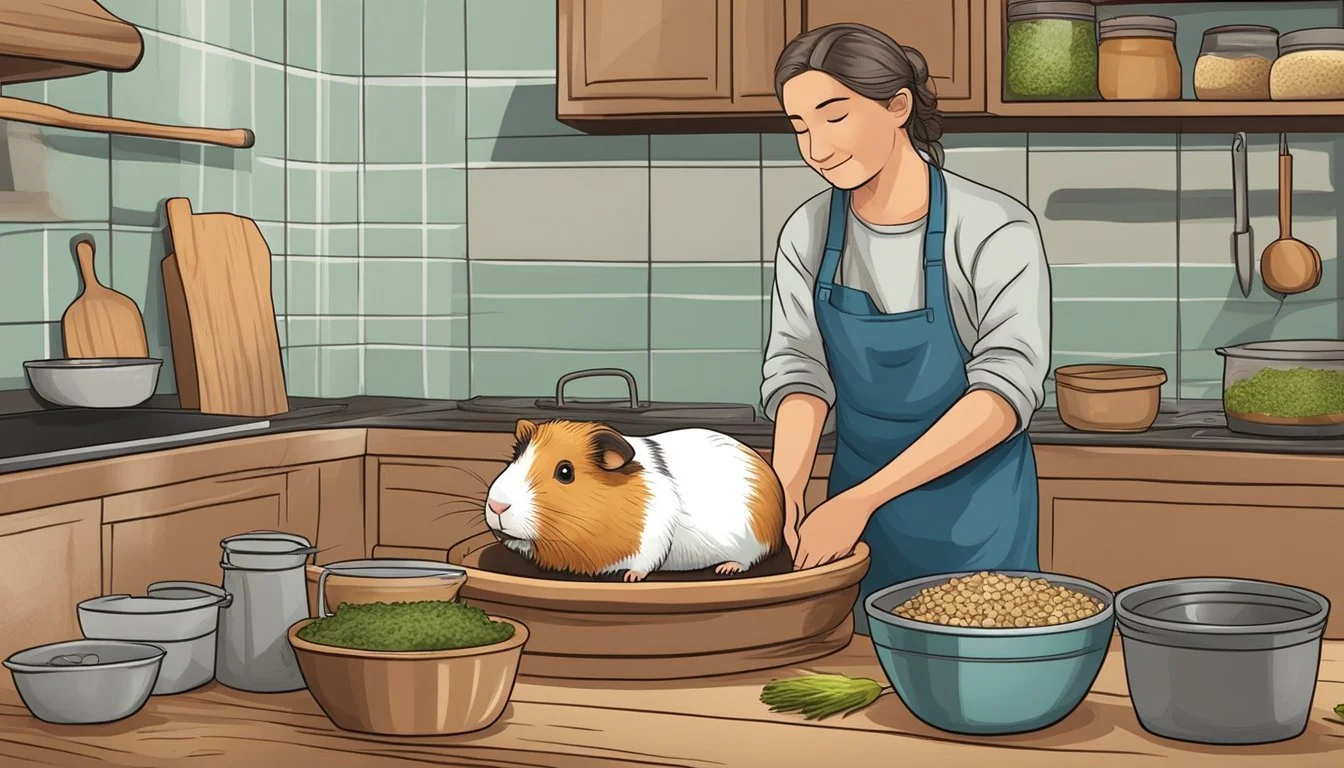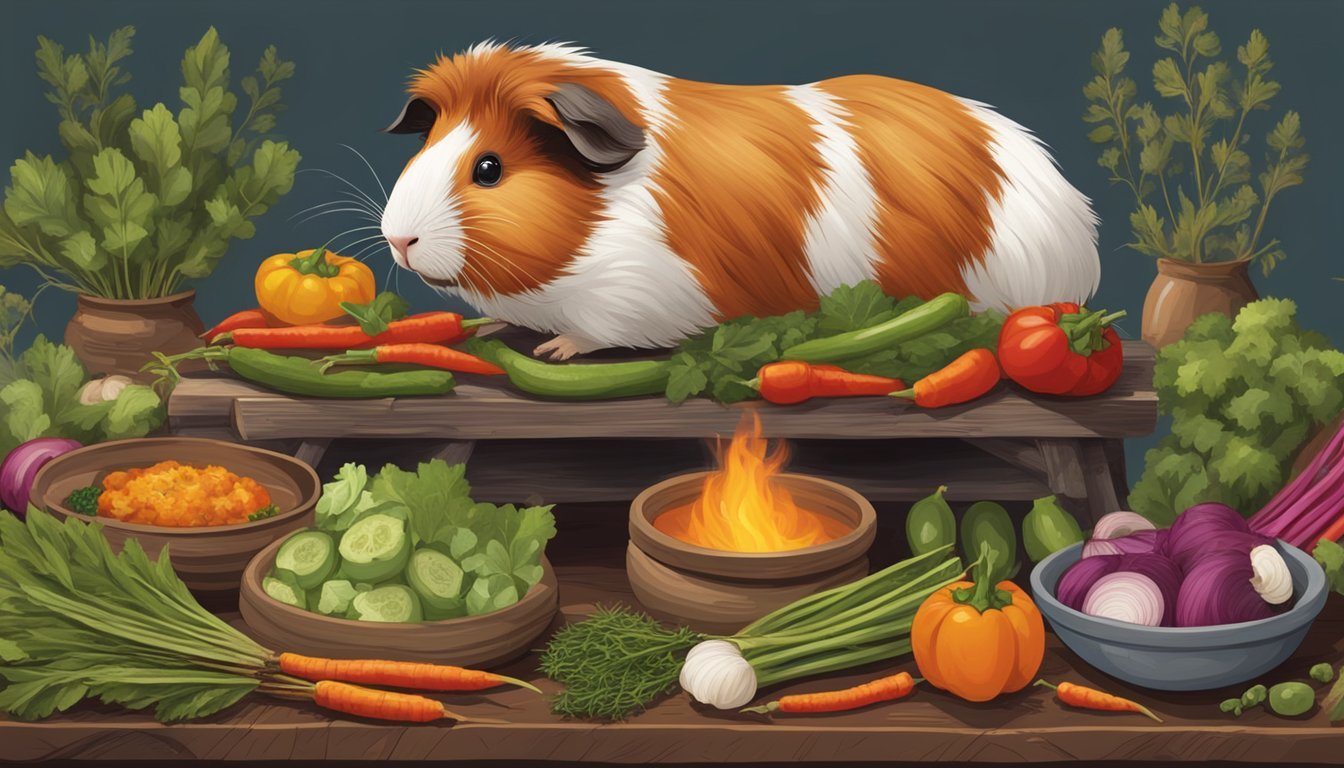Guinea Pig (Cuy)
Unveiling the Andean Culinary Tradition
Guinea pig, known as 'cuy' in the Andean regions, is more than just a household pet as it is typically known in Western societies. For centuries, it has been a significant part of Andean cuisine, valued for its nutritional content. High in protein and low in fat, cuy is a reliable food source, especially in the high-altitude areas of Peru where traditional farming can be challenging. In these communities, guinea pigs are raised domestically, which allows for easily manageable livestock that doesn't require the pasture land that other meat sources might.
The consumption of guinea pig dates back to the pre-Columbian era, where it played a vital role in both gastronomy and culture. In fact, cuy was historically regarded with such reverence that it was often involved in ritualistic offerings and ceremonies, with one such ceremony being the offering to the sun god, Inti, expressing gratitude for a bountiful harvest. This historical significance continues to be honored today, with cuy remaining a common sight in markets and on plates throughout the Andean region.
Today's culinary application of cuy in the Andean region showcases a blend of traditional and contemporary cooking methods, reflecting a deep respect for ancestral practices while embracing modern culinary exploration. The preparation of cuy involves meticulous cleaning and cooking, often accompanied by local herbs and ingredients that highlight the region's rich palate of flavors. This traditional dish is commonly reserved for special occasions, symbolizing wealth and prosperity, and it is enjoyed by locals and curious travelers alike, drawn to its unique place in Andean culture.
Historical Significance
The guinea pig, or cuy, is deeply embedded in Andean history and culture, serving not just as a food source but also as a creature of ritualistic importance. Their significance stretches back to pre-colonial times and continues to influence Andean societies today.
Guinea Pig in Andean Culture
Historically, the guinea pig has been more than a source of sustenance for people in the Andean region; it has also held a prominent cultural role. In Incan mythology and folklore, cuy were believed to possess spiritual significance. They were often depicted in Andean art and iconography, suggesting their importance in daily life and spirituality. Ceremonial offerings and sacrifices of guinea pigs to the gods were common, particularly as tributes to Inti, the sun god, to ensure a fruitful harvest and to promote fertility and social well-being.
Cuy in Pre-Colonial Diets
In the pre-colonial diets of Andean communities, cuy was a staple. They provided a valuable source of protein in an environment where other meat sources were scarce. The guinea pigs were domesticated and bred, becoming an integral part of the diet due to their manageable size and the efficiency with which they could be raised. This historical dietary role has led to a rich tradition of cuy as a culinary practice that continues to be a distinctive aspect of Andean culture and cultural heritage to this day.
Culinary Traditions
In the Andean region, the guinea pig, known as cuy, is not only a traditional food but also a cultural delicacy prepared through age-old techniques that are integral to festivals and celebrations.
Traditional Preparation Methods
The methods of preparing cuy hold deep-rooted significance in Peruvian cuisine. One popular preparation is cuy chactado, where the cuy is flattened and fried, often resulting in a crispy exterior. Another is cuy al horno, translating to roasted guinea pig, which involves baking the cuy, seasoned with various local herbs and spices, until tender.
Cuy chactado:
Preparation: The cuy is cleaned and seasoned, then pressed between stones and fried in oil.
Serving: Often presented whole on the plate.
Cuy al horno:
Preparation: After seasoning, the cuy is slow-roasted in an oven or over an open fire.
Serving: Accompanied by sides like potatoes and corn.
Cuy as a Festival Dish
Cuy figures prominently in festival feasts during national holidays and local celebrations. It is considered a delicacy and represents a fusion of flavor and tradition, with each region having its own unique twist on the dish. Consuming cuy is often a communal culinary experience, especially during important festivals like Inti Raymi, the Festival of the Sun.
Festivals:
National Holidays: Regularly featured as a special dish.
Inti Raymi: A significant time for cuy, traditionally offered as a sacred meal.
Culinary Experience:
Communal Eating: Cuy is often shared among family and friends.
Representation of Prosperity: Symbolizes wealth and is a source of nourishment.
Nutritional Value
Guinea pig, known as 'cuy' in the Andean region, stands out as a substantial source of nutrition. It is particularly noted for its protein content, which benefits the health of those who include it in their diet.
Protein Content and Health Benefits
Guinea pigs are high in protein, an essential macronutrient required for muscle repair, immune function, and overall health. They provide a lean source of protein with lower levels of cholesterol compared to many traditional meats. Each serving of guinea pig meat is rich in protein, making it an excellent dietary option for sustaining communities where alternative sources of protein may be less accessible.
Modern Consumption
In the Andean region, particularly within Peru, the consumption of cuy remains an integral cultural practice, evolving in presentation yet maintaining its traditional roots.
Cuy in Contemporary Restaurants
Cusco and other Andean cities are home to numerous restaurants that proudly feature cuy on their menus. Here, it is not uncommon to find cuy prepared in various styles ranging from roasted, known as cuy al horno, to a more elaborate preparation with spices and sauces. Some restaurants specialize in offering a modern twist to this traditional dish, aiming to cater to both locals and adventurous tourists seeking an authentic Peruvian experience.
Popularity: High in specific regions
Preparation Methods: Varied, with roasting being common
Audience: Locals and tourists
Presentation: Traditional and modern fusion
Perceptions and Popularity
The popularity of cuy among Peruvians reflects its deep-rooted cultural significance within the Andean society. While its consumption is widespread in certain areas, perceptions of cuy as a culinary item can differ greatly. In some urban and coastal areas, cuy may be viewed less favorably, often associated with indigenous highland culture. Despite this, cuy maintains its status as a delicacy and an essential part of festivities and everyday cuisine for many in the Andean region.
Cultural Significance: Strongly connected to Andean traditions
Regional Variance: Greater acceptance in the Andes compared to urban/coastal areas
Popular: Especially among those who value traditional culture
Cuy Versus Other Meats
In the Andean culinary tradition, cuy (guinea pig) holds a significant place due to its taste and cultural importance. This section compares cuy to more commonly consumed meats like chicken and rabbit, focusing on aspects such as fat content, taste, and size.
Comparison to Chicken and Rabbit
Size:
Cuy: On average, a cuy measures between 20 to 30 centimeters in length and weighs around 1 to 1.5 kilograms.
Chicken: Chickens are generally larger, with sizes varying widely by breed, but many meat breeds weigh in excess of 2 kilograms.
Rabbit: Similar in size to cuy, domestic meat rabbits can weigh from 2 to over 5 kilograms.
Taste:
Cuy: The meat of cuy is described as tender with a unique flavor, distinct from that of other meats due to its grassy and slightly gamy profile.
Chicken: Known for its versatility, chicken has a milder flavor and is often described as offering a blank canvas that absorbs the flavors of seasonings and marinades.
Rabbit: Rabbit meat is lean with a delicate flavor, often compared to chicken but with a denser, earthier taste.
Fat Content:
Cuy: Contains a higher fat content compared to rabbit, which contributes to its moist texture.
Chicken: Fat content varies with cuts, with dark meat being richer in fat than white meat.
Rabbit: Known for its leanness, rabbit has a low-fat profile, which can result in drier meat if not cooked carefully.
In culinary use, cuy is particularly valued in the Andean region for its tender meat and is often compared to chicken and rabbit in size and preparation methods. Each of these meats brings a distinct taste and texture to the table, contributing to diverse culinary experiences across cultures.
Preparing Cuy at Home
When cooking cuy, a traditional Andean delicacy, one should pay attention to the method of preparation and the spices used to achieve authentic flavors.
Recipes and Cooking Techniques
Marination: Chefs typically start by cleaning the cuy thoroughly. They then season it with a mixture of salt, cumin, and other spices such as pepper or ají (Peruvian hot pepper) for a depth of flavor. Garlic is often included in the marinade to impart a robust aroma.
Drying: Once seasoned, the cuy should be left to dry. Some choose to dry it in the sun, hanging on a cord.
Cooking: The traditional cooking method involves grilling the cuy over an open flame, turning it occasionally for even cooking. Alternatively, one might cut the cuy into sections, coat them with cornmeal, and fry in hot oil until crispy.
Example Recipe:
Marinade:
1 teaspoon salt
1 teaspoon ground cumin
1 tablespoon minced garlic
2 finely chopped ají peppers or substitute
Cooking:
If frying, use approximately 3 cups of vegetable oil for a crisp exterior.
Accompaniments: Cuy is often served with sides such as boiled potatoes or a sauce made from ají and other local ingredients.
By following these steps and using the right combination of ingredients, one can prepare cuy with confidence, capturing the essence of Andean culinary tradition.
Cuy in the Arts and Religion
The guinea pig, or cuy, not only holds a place of importance in the diet of the Andean people but also in their art and religious practices. It appears in significant religious paintings and is intertwined with the spiritual beliefs of the region.
Cuy Depictions in Art
Artistic representations of cuy can be observed in various mediums, but they are most famously included in religious artwork. A notable example is the 1753 painting of "The Last Supper" by Marcos Zapata. Located in Cuzco's main cathedral, this painting depicts Christ and his disciples dining on cuy, thereby integrating this indigenous animal into a pivotal Christian narrative. This incorporation of cuy into religious painting highlights the syncretism between Andean culture and introduced Christian elements.
Religious Significance
In Andean spirituality, cuy holds a sacred status that transcends its nutritional value. It is known to have been used as a sacrifice to Inti, the sun god, as a token of gratitude for a bountiful harvest. The act of offering cuy as a sacrifice reinforces its revered standing in the religious and cultural fabric of Andean communities. This practice reflects the deep ties between everyday sustenance provided by animals like cuy and the spiritual gratitude expressed by the people to their deities.
International Perspectives
Guinea pig, or cuy, is a traditional delicacy in the Andean region, which has garnered both intrigue and aversion from international diners.
Reception outside South America
In the United States and Europe, the perception of guinea pigs is quite different from that of South America. They are commonly viewed as pets rather than a source of food, which often leads to a cultural disconnect when confronted with the idea of consuming them. The reception of cuy as a culinary item varies among international communities.
While there is a general curiosity in trying traditional cuisines, the practice of eating guinea pig has not become mainstream in the US or Europe. Travelers often encounter cuy on menus while visiting South America and their reaction can swing from eagerness to taste an authentic dish to reluctance, largely due to the pet status guinea pigs hold in their home countries.
In western culinary circles, some chefs have introduced cuy to showcase authentic South American cuisine, targeting diners with an adventurous palate. Their efforts tend to attract attention and stimulate discussion about culinary diversity and food sustainability, presenting cuy as an environmentally friendly meat option due to guinea pigs’ smaller ecological footprints compared to traditional livestock.
The United States has a niche market for cuy among South American expatriates who maintain their traditional culinary practices. Meanwhile, the European response remains cautious, with only a fringe group of culinary enthusiasts showing interest in integrating guinea pig into their diet.
The reception of cuy on the international stage is a complex blend of curiosity, cultural sensitivity, and sustainable food practice interest, shaped by each region’s unique relationship with the animal.
Sustainability and Farming Practices
Guinea pig (Cuy) farming in the Andean region couples resilience in food security with low environmental impact, exemplifying a sustainable practice deeply rooted in local traditions. Farmers utilize guinea pigs as a dietary staple and income source, with practices honed over centuries.
Raising Cuy for Sustenance
Cuy farming is a traditional practice dating back thousands of years in the Andean region. Farmers raise guinea pigs as a significant dietary staple due to their high protein content and low-fat profile. The breeding cycle of Cuy is short, and they reproduce rapidly, ensuring a consistent food supply. Furthermore, they require minimal space and can thrive on food scraps, making them suitable for small-scale farming. This contributes to food sustenance and offers economic resilience for local communities.
Environmental Impact
The environmental footprint of Cuy farming is notably small. They convert feed to protein efficiently, much more so than cattle or pigs, leading to less strain on natural resources. Their manure serves as an excellent fertilizer, contributing to a reduced need for chemical alternatives and promoting a healthier ecosystem. Additionally, Cuy farming does not demand extensive land alteration, preserving the environment and helping maintain biodiversity.
Cultural Variations
In the diverse Andean region, cuy holds varying levels of culinary and cultural significance that reflect the rich heritage of each country.
Regional Differences in Andean Countries
Peru:
Cuisine: Cuy is a celebrated dish, intricately tied to festivals and special occasions.
Preparation: Often roasted whole and seasoned with a blend of regional spices.
Ecuador:
Cuisine: While also popular, the presence of cuy in everyday meals is less pronounced than in Peru.
Tradition: Served during significant community events and as a special treat rather than a staple.
Bolivia:
Usage: Here, cuy may be found in a variety of dishes but typically features in rural and indigenous communities.
Cultural Impact: Considered a traditional food that connects Bolivians to their ancestral roots.
Colombia:
Presence: Less pervasive in the national diet, cuy is reserved for certain regional cuisines within the Andes.
Appreciation: Although not as integral to the national identity as in Peru, it is still cherished in rural Andean communities.
This juxtaposition across countries in South America showcases a common thread interwoven with unique local practices.
Cuy in Gastronomic Tourism
Gastronomic tourism in the Andean region often features the unique opportunity to taste cuy, a local delicacy that provides a memorable culinary experience for visitors.
Cuy Tasting Experiences for Visitors
Cusco and Arequipa are prominent cities where gastronomic tourists can indulge in tasting cuy, a traditional Andean dish. The eateries that specialize in cuy are colloquially known as cuyerías. These establishments often offer a farm-to-table experience where diners can observe the traditional methods of cooking cuy, typically roasted over an open flame and served whole.
Culinary Experience:
Preparation: Restaurants pride themselves on the preparation of cuy, which is an art in itself, involving a careful blend of regional herbs and spices.
Presentation: Cuy is typically presented with a selection of local accompaniments such as potatoes, corn, and aji, a Peruvian hot sauce.
Tasting: Visitors are encouraged to immerse themselves in the cultural aspect of dining by eating cuy in the traditional manner with their hands.
Tourists seeking a complete gastronomic tourism experience in these regions can learn about the historical significance of cuy while enjoying the flavors and hospitality of the local communities.
Accompaniments and Side Dishes
When serving cuy, a variety of side dishes complement its rich flavor. These traditional accompaniments enhance the culinary experience and provide a well-rounded meal.
Common Pairings with Cuy
Potatoes: A staple in the Andean diet, potatoes often accompany cuy. They can be served boiled or as part of a dish like papa a la Huancaína, with a creamy, spicy sauce.
Yellow Potatoes: These are particularly favored for their unique, slightly sweet flavor and creamy texture.
Corn: Another traditional side is corn, which may be presented on the cob or as kernels, often toasted to bring out their nutty taste.
Rice: Simple and unassuming, white rice works as a neutral base to balance the distinctive taste of cuy, making it a common partner on the plate.
Salsa Criolla: This tangy onion relish provides a refreshing counterpoint to the savory meat with its vibrant combination of thinly sliced onions, lime juice, and coriander.
Salad: A light salad, with lettuce, tomatoes, cucumbers, and perhaps some avocados, offers a crisp, clean contrast to the richness of the cuy.
Etiquette and Eating Practices
When eating cuy, or guinea pig, diners in the Andean region follow certain etiquette to honor cultural traditions and display respect for this historic dish.
How to Eat Cuy Properly
One typically eats cuy with their hands, using napkins generously to keep tidy, as the dish can be quite greasy. In some formal settings, however, utensils may be provided and their use is expected to align with local dining etiquette. The eating process is methodical, starting from one end of the cuy and working towards the other end, ensuring that all the meat is consumed; this is both a sign of respect for the food and an adherence to eating practices that minimize waste.
While eating in someone's home, it is polite to finish what is served, as cuy is often reserved for special occasions and rejecting it could be considered impolite. No part of the meal is taken to bed or saved for later within traditional customs; it’s expected that one finishes their serving at the table in appreciation of the host's effort and the cultural significance of the meal.
Expansion of Cuy Cuisine
The rise of cuy as a food source is not confined to its Andean roots; it has begun to take on a more global presence, where it meets varied receptions.
Cuy's Growth Beyond the Andean Region
In recent years, the traditional Andean dish known as cuy has seen its consumption expand beyond the mountainous regions of South America. Cuy, which is a domesticated guinea pig, has been a vital food source in the Andean region due to its high protein content and sustainability.
In the West, particularly within immigrant communities in the United States, cuy has started to feature on the menus of South American restaurants, introducing this traditional Andean staple to a broader audience. However, this expansion faces cultural hurdles as guinea pigs are commonly seen as pets rather than a source of meat in many Western societies.
Despite the cultural shock in some regions, the culinary curiosity and rising interest in ethnic foods have contributed to cuy’s slow but steady introduction into new gastronomic territories. Chefs specializing in South American cuisines are incorporating cuy into their offerings, which might pave the way for this delicacy to gain more acceptance as part of an exotic and authentic culinary experience outside its region of origin.
The expansion of cuy cuisine demonstrates the complex dynamics of cultural exchange and the potential for traditional foods to find new markets, shaped by both cultural appreciation and resistance.
Anatomy of the Cuy
The anatomy of the cuy is distinctive, lending itself well to both traditional Andean husbandry and culinary practices.
Understanding Cuy Anatomy and Preparation
Cuys, commonly known as guinea pigs, are small rodents that possess certain characteristics making them suitable for consumption. Their size, typically between 20 to 30 centimeters in length, allows for easy handling and preparation. With a weight range of approximately 1 to 1.5 kilograms, they provide a modest amount of meat, which is an important protein source in the Andean regions.
The structure of the cuy includes a rounded head, prominent ears, and a body covered with fur that can vary in color. The fur of the Peruvian guinea pig is noted for its diverse variations, which distinguish them from other rodent species. The teeth of the cuy are constantly growing, necessitating a diet that helps wear them down.
In preparation for cooking, the cuy's fur is removed, and the carcass is cleaned thoroughly. This process involves eliminating the hair and internal organs, to ensure the meat is safe and ready for consumption. Afterward, cuys may be dipped in water mixed with lime juice and left to dry, a step that contributes to the final flavor and texture of the dish.
Innovations in Cuy Cuisine
In the dynamic culinary landscape of the Andean region, cuy cuisine is experiencing inventive transformations, expanding far beyond traditional cooking methods.
New Culinary Approaches to Cuy
Chefs throughout the Andean region have begun to push the boundaries of traditional cuy preparations. One of the most innovative approaches involves deep-fried cuy, creating a product that is exceptionally crispy and rich in flavor. This technique not only provides a novel texture but also enhances the taste, offering an enticing alternative to the commonly roasted or boiled variations.
In addition to deep-frying, there is cuy al palo, which is cuy cooked on a spit. This method involves slow-roasting the cuy over an open fire, resulting in a smoky and subtle taste. The slow rotation on the spit ensures the meat is evenly cooked, maintaining juiciness while achieving a pleasing outer crispiness.
Amidst these innovations, the spirit of authentic Andean cuisine is retained, while the culinary techniques continue to develop and adapt, honoring tradition with modern flair. Chefs are not only elevating the dish with new flavors and textures but also presenting it in a way that appeals to both local palates and international food enthusiasts.
The Future of Cuy as a Protein Source
As global demand for sustainable protein sources increases, the Peruvian guinea pig, or cuy, presents notable opportunities and faces certain challenges. The section below presents an informed perspective on what lies ahead for cuy as a protein source.
Prospects
The prospects for cuy as a protein source are promising due to several factors:
Sustainability: Cuy farming is resource-efficient, requiring less water and land than traditional livestock.
Nutritional Value: As a high-protein, low-fat option, cuy meat is nutritionally rich, making it an appealing alternative to beef, pork, or chicken.
Cultural Acceptance: In the Andean region, there is a strong tradition of cuy consumption, which may ease its expansion into new markets looking for authentic culinary experiences.
Challenges
However, cuy farming faces certain challenges that could impact its viability as a future protein source:
Scaling Production: Efficiently scaling cuy farming while maintaining animal welfare and meat quality is a complex task.
Market Perception: Outside of South America, there may be resistance to adopting cuy due to differing cultural perceptions of guinea pigs as pets rather than as livestock.
Regulatory Hurdles: Navigating food safety regulations and standards can be challenging for new animal products entering various markets.
Ensuring that cuy can meet future protein demands will require innovation, education, and investment in sustainable farming practices.
Cuy in Rural Communities
In the rural villages of the Andean region, cuy, or guinea pig, is not merely a source of nutrition but a cornerstone of community life and economic stability.
Socio-Economic Role of Cuy Farming
Rural communities in the Andean highlands have long depended on cuy farming as an essential economic activity. The small stature of guinea pigs and their ability to thrive on a diet of vegetable scraps make them an economically viable livestock for local households. Typically, a family's cuy operations are small-scale but are pivotal for income generation and sustenance.
Cuy serve multiple socio-economic functions. They are a traditional resource that local residents raise for direct consumption and for supplementary income. The revenue stream from cuy can be significant relative to other agricultural activities. A family involved in cuy farming might see substantial monthly earnings from their operations, offering financial resilience against the unpredictable nature of farming in the region. This elevation in economic status can create opportunities for better living conditions, education, and nutrition.
In addition to their economic value, guinea pigs play a cultural and social role, being integrated into local celebrations and customs. Their care and breeding often involve the whole family, teaching responsibility and animal husbandry from a young age. These activities support the transmission of cultural practices and knowledge across generations within these communities.
Cuy Preparations Around the World
In various cultures around the globe, the preparation of cuy, or guinea pig, reflects a blend of traditional practices and contemporary culinary exchange. Dishes featuring this ingredient demonstrate how foods can traverse borders and adapt to local palates.
Dishes and Influences in Various Cultures
Peru: Arguably the heart of cuy cuisine, Peruvian dishes like cuy chactado, where the animal is deep-fried until its skin is crispy, and cuy al horno, or roasted guinea pig, are local favorites. Peruvian preparations often involve marinating the meat in seasonings unique to the region, providing an authentic Andean flavor.
Ecuador: Ecuadorians also consider cuy a traditional dish, usually preparing it roasted for special occasions and serving it with sides like potatoes and aji, a local hot sauce.
Colombia: In Colombia, cuy is typically roasted or grilled and is especially popular in the southern regions, reflecting the country's cultural ties with its Andean neighbors.
Bolivia: Bolivian cuisine features cuy as well, with preparations similar to Peru and Ecuador. It is often prepared for ceremonial purposes, highlighting its cultural significance in addition to its culinary uses.
Globally, the culinary traditions surrounding cuy are a robust example of cultural exchange. As travelers and immigrants introduce their cuisines to new regions, a global influence becomes apparent. The dish has made appearances in ethnic enclaves around the world, developing a niche following and occasionally being fused with other cooking styles in a display of global culinary syncretism.
Cuy and Animal Ethics
The consumption of guinea pigs, known as cuy, raises important ethical considerations that extend from cultural significance to animal welfare concerns.
Ethical Considerations in Cuy Consumption
Ethical discourse around cuy consumption often centers on two main points: the cultural importance of guinea pigs as a traditional food source and the perspectives that view them predominantly as pets. The debate becomes more complex considering the differing standards of animal ethics across cultures.
Cultural Context: In the Andean region, guinea pigs have been a key element of the diet for centuries, providing a source of protein and forming part of local customs and celebrations.
Animal Welfare: Concerns about the well-being of guinea pigs emerge when these animals are bred and raised for consumption. Ethical considerations include the conditions in which they are kept, their treatment during their life, and the method of their slaughter.
People who oppose the consumption of cuy often do so from a standpoint that primarily considers guinea pigs as pets. This viewpoint is influenced by Western societal norms where guinea pigs are commonly seen as household companions rather than a food source. In contrast, Andean communities value guinea pigs both as a source of sustenance and a cultural heritage, which may differ from Western animal ethics standards.
The discourse on cuy consumption is an example of the diverse ethical beliefs that coexist in our global society. It highlights the importance of understanding the cultural context behind dietary choices and the varied perceptions of animal ethics worldwide.
Cuy in Literature and Media
Guinea pig, or cuy as it's more commonly known in the Andean region, has made its presence known in various forms of literature and media, mirroring its cultural significance.
Representation in Books and Film
In literature, cuy often features in works that explore Andean culture and traditions. Authors may use cuy as a narrative device to delve into social issues or highlight the clash between modernity and tradition within these communities. Additionally, the mention of cuy in literary texts can signal a connection to Andean religious practices and belief systems.
Films that focus on or are set in the Andean regions can't escape the cultural relevance of cuy, which may be portrayed in rituals, as part of everyday life, or even as a subject of conflict. In both books and films, cuy represents more than just food; it is a symbol of identity and continuity of cultural heritage.
Notable appearances:
Literature: The presence of cuy in Andean-related literature serves as a cultural touchstone, helping to authenticate the narrative.
Film: When cuy appears on screen, it often prompts discussions among viewers unfamiliar with its role outside of a pet status in other cultures.
Cuy Festivals and Celebrations
In the Andean region, guinea pig, known locally as cuy, holds a particular place in both public and religious festivities, reflecting its significance in tradition and culture.
Role in Public and Religious Festivities
Festivals: Cuy is prominently featured during various festivals in the Andean communities. These festivals often have historical roots and are steeped in indigenous customs, combining both public jubilation and veneration of cultural practices.
La Fiesta de San Juan: Celebrated every June, this festival honors Saint John the Baptist and is marked by communal meals featuring cuy as a special dish.
Inti Raymi: A notable solstice festival, Inti Raymi is where cuy has a sacred role. This Incan celebration pays homage to the sun god Inti, and cuy is prepared in honor of this deity to symbolize gratitude for the year's harvest.
Religious Festivities: Cuy's role in religious events is not just as a food source but also as a ritual offering.
Christmas and Easter: During these significant Christian holidays, cuy is often part of the feast, linking traditional beliefs with religious observances.
Local Patron Saint Days: On the days honoring various patron saints, cuy is included in the feast, sometimes following a religious procession or mass, emphasizing community and shared heritage.









